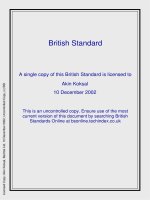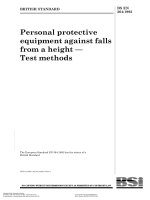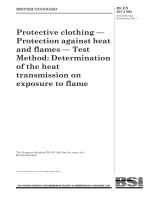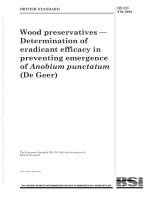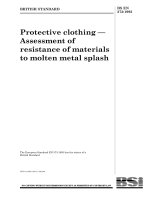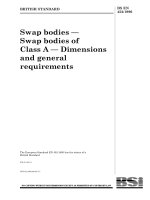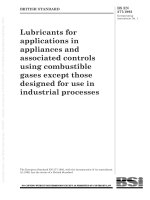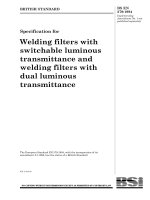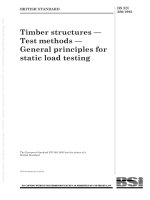Bsi bs en 61329 1996 (1999)
Bạn đang xem bản rút gọn của tài liệu. Xem và tải ngay bản đầy đủ của tài liệu tại đây (402.84 KB, 18 trang )
BRITISH STANDARD
Sound system
equipment —
Methods of measuring
and specifying the
performance of
sounders
(electroacoustic
transducers for tone
production)
The European Standard EN 61329:1996 has the status of a
British Standard
ICS 33.160.30
BS EN
61329:1996
IEC 1329:1995
BS EN 61329:1996
Committees responsible for this
British Standard
The preparation of this British Standard was entrusted by Technical
Committee EPL/100, Audio, video and multimedia systems and equipment, to
Subcommittee EPL/100/3, Equipment and systems in the field of audio, video
and audiovisual engineering, upon which the following bodies were
represented:
Association of British Theatre Technicians
Audio Engineering Society
British Broadcasting Corporation
British Educational Suppliers’ Association
British Radio and Electronic Equipment Manufacturers’ Association
British Telecommunications plc
Federation of British Audio
Federation of the Electronics Industry
Independent Television Association
Institute of Sound and Communication Engineers
Institution of Electrical Engineers
International Association of Broadcasting Manufacturers
Professional Lighting and Sound Association
Royal Institute of British Architects
Society of Cable Television Engineers
This British Standard, having
been prepared under the
direction of the Electrotechnical
Sector Board, was published
under the authority of the
Standards Board and comes
into effect on
15 August 1996
© BSI 10-1999
The following BSI references
relate to the work on this
standard:
Committee reference EPL/100/3
Draft for comment 93/203886 DC
ISBN 0 580 26103 4
Amendments issued since publication
Amd. No.
Date
Comments
BS EN 61329:1996
Contents
Committees responsible
National foreword
Foreword
Text of EN 61329
List of references
© BSI 10-1999
Page
Inside front cover
ii
2
3
Inside back cover
i
BS EN 61329:1996
National foreword
This British Standard has been prepared by Subcommittee EPL/100/3 and is the
English language version of EN 61329:1996 Sound system equipment — Methods
of measuring and specifying the performance of sounders (electroacoustic
transducers for tone production), published by the European Committee for
Electrotechnical Standardization (CENELEC). It is identical with
IEC 1329:1995, published by the International Electrotechnical Commission
(IEC).
Cross-references
Publication referred to Corresponding British Standard
EN 60651:1994
(IEC 651:1979)
EN 1094-1:1994
(IEC 1094-1:1992)
EN 1094-4:1995
(IEC 1094-4:1995)
HD 483.1 S2:1989
(IEC 268-1:1985)
HD 483.2 S2:1993
(IEC 268-2:1987)
BS EN 60651:1994 Specification for sound level meters
BS EN 61094 Specification for measurement microphones
BS EN 61094-1:1995 Specifications for laboratory
standard microphones
BS EN 61094-4:1996 Specifications for working standard
microphones
BS 6840 Sound system equipment
Part 1:1987 Method for specifying and measuring general
characteristics used for equipment performance
Part 2:1993 Glossary of general terms and calculation
methods
Additional information a CENELEC editorial correction has been
incorporated; In Figure 4 and Figure 5 “(see 5.6.1)” has been replaced by
“(see 5.5.1)”.
A British Standard does not purport to include all the necessary provisions of a
contract. Users of British Standards are responsible for their correct application.
Compliance with a British Standard does not of itself confer immunity
from legal obligations.
Summary of pages
This document comprises a front cover, an inside front cover, pages i and ii,
the EN title page, pages 2 to 12, an inside back cover and a back cover.
This standard has been updated (see copyright date) and may have had
amendments incorporated. This will be indicated in the amendment table on the
inside front cover.
ii
© BSI 10-1999
EUROPEAN STANDARD
EN 61329
NORME EUROPÉENNE
January 1996
EUROPÄISCHE NORM
ICS 17.140.50
Descriptors: Electroacoustics, electroacoustic transducers, acoustic signals, definitions, characteristics, performance evaluation,
quality, classification, measurement methods
English version
Sound system equipment
Methods of measuring and specifying the performance of
sounders (electroacoustic transducers for tone production)
(IEC 1329:1995)
Equipements pour systèmes électroacoustiques
Méthodes de mesure et de spécification de la
qualité de fonctionnement des sondeurs
(transducteurs électroacoustiques de
production de sons)
(CEI 1329:1995)
Geräte für Tonsysteme
Verfahren zur Messung und Angabe der
Leistungskennwerte von Schallgebern
(Elektroakustische Wandler zur Tonerzeugung)
(IEC 1329:1995)
This European Standard was approved by CENELEC on 1995-11-28.
CENELEC members are bound to comply with the CEN/CENELEC Internal
Regulations which stipulate the conditions for giving this European Standard
the status of a national standard without any alteration.
Up-to-date lists and bibliographical references concerning such national
standards may be obtained on application to the Central Secretariat or to any
CENELEC member.
This European Standard exists in three official versions (English, French,
German). A version in any other language made by translation under the
responsibility of a CENELEC member into its own language and notified to the
Central Secretariat has the same status as the official versions.
CENELEC members are the national electrotechnical committees of Austria,
Belgium, Denmark, Finland, France, Germany, Greece, Iceland, Ireland, Italy,
Luxembourg, Netherlands, Norway, Portugal, Spain, Sweden, Switzerland and
United Kingdom.
CENELEC
European Committee for Electrotechnical Standardization
Comité Européen de Normalisation Electrotechnique
Europäisches Komitee für Elektrotechnische Normung
Central Secretariat: rue de Stassart 35, B-1050 Brussels
© 1996 Copyright reserved to CENELEC members
Ref. No. EN 61329:1996 E
EN 61329:1996
Foreword
Contents
The text of document 84/407 + 407A/DIS, future
edition 1 of IEC 1329, prepared by IEC TC 84,
Equipment and systems in the field of audio, video
and audiovisual engineering, was submitted to the
IEC-CENELEC parallel vote and was approved by
CENELEC as EN 61329 on 1995-11-28.
The following dates were fixed:
Page
Foreword
2
1
Scope and object
3
2
Normative references
3
3
Definitions and symbols
3
3.1 Classification, structures and components 3
3.2 Characteristics, symbols and units
3
4
Rated conditions
4
5
Characteristics and measuring methods
5
5.1 Measuring conditions
5
5.2 Measuring equipment
5
5.3 Electroacoustic transducer
characteristics of the sounder
6
5.4 Electrical and mechanical
characteristics of sounders
7
5.5 Piezoelectric diaphragm
7
6
Physical and other characteristics
7
6.1 Characteristics for all transducers
7
6.2 Characteristics for sounders
7
6.3 Characteristics for piezoelectric
diaphragms
7
7
Classification of the characteristics
to be specified
8
Annex A (informative) Bibliography
12
Annex ZA (normative) Normative references
to international publications with their
corresponding European publications
12
Figure 1 — Voltage and d.c. component
of square-wave signals
9
Figure 2 — Diagram of sounder
measuring system
10
Figure 3 — Diagram of sounder testing system 11
Figure 4 — Diagram of piezoelectric
diaphragm measuring system
11
Figure 5 — Example of a diaphragm supporter 11
Table 1 — Characteristics of sounders to
be specified, and classification
8
Table 2 — Characteristics of piezoelectric
diaphragm to be specified, and classification
8
— latest date by which the EN
has to be implemented at
national level by
publication of an identical
national standard or by
endorsement
(dop) 1996-09-01
— latest date by which the
national standards
conflicting with the EN
have to be withdrawn
(dow) 1996-09-01
Annexes designated “normative” are part of the
body of the standard. Annexes designated
“informative” are given for information only. In this
standard, Annex ZA is normative and Annex A is
informative. Annex ZA has been added by
CENELEC.
2
© BSI 10-1999
EN 61329:1996
1 Scope and object
This International Standard is applicable to
sounders, which are treated as entirely passive
electroacoustic transducer elements. Piezoelectric
diaphragms, which are the principal components of
piezoelectric sounders, are also included. Buzzers
which are sound sources with built-in electric
circuits are excluded.
The object of this standard is to standardize the
definitions relating to these electroacoustic
transducers, and to list characteristics to be
specified and the relevant methods of measurement.
2 Normative references
The following normative documents contain
provisions which, through reference in this text,
constitute provisions of this International Standard.
At the time of publication, the editions indicated
were valid. All normative documents are subject to
revision, and parties to agreements based on this
International Standards are encouraged to
investigate the possibility of applying the most
recent editions of the normative documents listed
below. Members of IEC and ISO maintain registers
of currently valid International Standards.
IEC 268-1:1985, Sound system equipment —
Part 1: General.
IEC 268-2:1987, Sound system equipment —
Part 2: Explanation of general terms and
calculation methods.
IEC 651:1979, Sound level meters.
IEC 1094-1:1992, Measurement microphones —
Part 1: Specifications for laboratory standard
microphones.
IEC 1094-4:1995, Measurement microphones —
Part 4: Specifications for working standard
microphones.
3 Definitions and symbols
For the purpose of this International Standard, the
following definitions and symbols apply.
3.1 Classification, structures and components
3.1.1
sounder
electroacoustic transducer for the production of
single or multiple tone signals
3.1.2
buzzer
device consisting of a sounder and an electric circuit
for self-excited or externally excited oscillation
NOTE
Buzzers are not included in this standard.
© BSI 10-1999
3.1.3
electromagnetic sounder
sounder consisting of a diaphragm with an
electromagnetic driver (e.g. a moveable armature or
a magnet driven by electromagnetic force), built in a
housing
3.1.4
electrodynamic sounder
sounder consisting of a diaphragm with an
electro-dynamic driver (e.g. a moveable coil or flat
electric conductor pattern in a magnetic field), built
in a housing
3.1.5
piezoelectric sounder
sounder consisting of a piezoelectric diaphragm
built in a housing
3.1.6
piezoelectric diaphragm
diaphragm consisting of a metal plate and one or
two piezoelectric ceramic plates cemented together
so that radial expansion and contraction of the
ceramic plate(s) is transformed to bending of the
diaphragm for sound radiation
3.1.7
piezoelectric ceramic plate; piezoelectric
ceramic disc
thin plate made of a piezoelectric ceramic, for
example lead zirconate titanate (PZT) ceramic, of
which each side is metallized. The ceramic plate is
polarized so as to deform radially when a voltage is
applied across it
3.2 Characteristics, symbols and units
3.2.1
input voltage (sinusoidal signal)
RMS voltage of a sinusoidal signal applied to a
sounder or a piezoelectric diaphragm. Symbol: Urms,
unit: V
3.2.2
input voltage (square wave signal)
peak-to-peak voltage of a square-wave signal
applied to a sounder. Symbol: Upp, unit: V
NOTE The sounder or piezoelectric diaphragm may require, or
tolerate, a d.c. component in addition to the square wave, in
which case the required or tolerated signal waveform will be
specified, as illustrated in Figure 1.
3.2.3
d.c. polarity (of an electromagnetic or an
electrodynamic sounder)
direction of the d.c. component applied to an
electromagnetic or electrodynamic sounder which is
designed to be driven by a positively-biased or
negatively-biased square-wave input voltage
3
EN 61329:1996
3.2.4
direction of polarization (of a piezoelectric
ceramic plate)
3.2.11
reference point (of microphone)
direction of the d.c. voltage, applied for polarization
of the piezoelectric ceramic during production
point where the principal axis of the microphone
intersects the reference plane. For additional
information, see note to 3.2.10
3.2.5
resonant frequency (of a sounder)
4 Rated conditions
frequency within the rated frequency range, at
which the output sound pressure of a sounder shows
a local maximum. Symbol: fr, unit: Hz
For a full explanation of the terms “rated value” and
“rated condition”, see IEC 268-2. The following
conditions shall be specified by the manufacturer of
the sounder.
3.2.6
resonant frequency (of a piezoelectric
diaphragm)
frequency close to the eigenfrequency of the first
symmetrical vibration mode for the free boundary
condition, at which the electrical impedance of the
piezoelectric diaphragm shows a local minimum.
Symbol: fr, unit: Hz
3.2.7
anti-resonant frequency (of a piezoelectric
diaphragm)
frequency close to the eigenfrequency of the first
symmetrical vibration mode for the free boundary
condition, at which the electrical impedance of a
piezoelectric diaphragm shows a local maximum.
Symbol: fa, unit: Hz
3.2.8
sensitivity level to voltage (with A-weighting)
output sound pressure level of a sounder measured
using a sound level meter with A-weighting,
referred to an input voltage of 1 V and to a distance
of 1 m. The measuring frequency and input signal
waveform are as specified by the manufacturer.
Symbol: SA, unit: dB ref. 20 4Pa
NOTE
The A-weighting characteristic is specified in IEC 651.
3.2.9
distance to measuring point:
distance between the reference point of a sounder to
be measured and the reference point of the
microphone used for the measurements, specified as
one of the measuring conditions. Symbol: r, unit: m
3.2.10
principal axis (of microphone)
line through the geometrical centre, and
perpendicular to the reference plane, of the
microphone used for measurement
NOTE The front surface of the microphone should be taken as
the reference plane, if the reference plane of the microphone is
not specified by the manufacturer.
4
4.1 Rated input voltage
The continuous input voltage at which the sounder
operates normally for the specified period of time.
The frequency and waveform of the input signal
shall be specified. Symbol: Ur, unit: V.
4.2 Rated maximum input voltage
The maximum voltage which can be applied to the
sounder for a specified short time. The frequency
and waveform of the input signal shall be specified.
Symbol: Um, unit: V.
4.3 Rated frequency range
The frequency range for continuous sinusoidal input
signal over which the sounder can operate normally.
The input voltage shall be specified.
4.4 Rated resistance
The d.c. resistance of an electromagnetic or
electrodynamic sounder specified for matching
purposes. Symbol: Rr, unit: 7
4.5 Rated capacitance
The electrical capacitance of the piezoelectric
sounder specified for matching purposes.
Symbol: Cr, unit: nF.
4.6 Principal axis (of sounder)
The line through the geometrical centre of the sound
hole(s), perpendicular to the front surface of the
sounder. For additional information, see note to 4.7.
4.7 Reference point (of sounder)
The point where the principal axis of the sounder
intersects the front surface.
NOTE Strictly, this term and that defined in the previous
subclause should include the word “rated” (for example, “rated
reference point”), since they are specified by the manufacturer in
accordance with these definitions and cannot be measured, but
confusion is unlikely even if the shorter terms are used.
4.8 Rated working temperature range
The environmental temperature range over which a
sounder can operate normally.
© BSI 10-1999
EN 61329:1996
5 Characteristics and measuring
methods
5.1 Measuring conditions
5.1.1 Environmental noise and other
interferences
The disturbance of measured sound pressure level
due to environmental or other noises shall not
exceed 1 dB.
5.1.2 Climatic and environmental conditions
Unless otherwise specified by the manufacturer,
measurements shall be made under the following
environmental conditions:
— ambient temperature:
— relative humidity:
— air pressure:
15 °C to 35 °C,
preferably at 20 °C;
25 % to 75 %;
86 kPa to 106 kPa.
NOTE For further information, see IEC 268-1, IEC 68 and
IEC guide 106.
5.1.3 Acoustic environment for measurement
In the frequency range 500 Hz to 10 kHz, the
variation, due to acoustic reflections or
reverberation, of sound pressure level with distance
shall not deviate by more than 1 dB from the
response in an ideal free sound field, in the range of
distance from 0,1 m to that of the measuring point.
5.1.4 Measuring signal waveform
The waveform of the signal for measurement shall
be sinusoidal or square. The signal voltage shall be
stated as the r.m.s. value for a sinusoidal signal and
as the peak-to-peak value for a square wave signal.
For a square-wave signal, information on any
necessary d.c. component shall be given
(see Figure 1).
5.2 Measuring equipment
5.2.1 Sound level meter
A sound level meter conforming to the requirements
of IEC 651 shall be used. The weighting
characteristic “A” shall be used except for the
frequency response measurement. The dynamic
characteristic “F” shall be used for all the
measurements. The “S” characteristic may be used
only if the difference in the measurement is
negligible.
5.2.2 Microphone for measurement
A microphone as described in IEC 1094-1 or
IEC 1094-4 shall be used. Either the pressure type
(P type) or the free-field type (F type) may be used.
© BSI 10-1999
5.2.3 Automatic frequency response recorder
Interruption of the signal frequency trace at any
instant during the measurement should not affect
the indicated response by more than 1 dB.
5.2.4 Sinusoidal signal generator and
amplifier
The amplifier associated with a sinusoidal signal
generator shall conform with the following
requirements:
a) the amplifier shall be stable when connected to
the sounder under the test;
b) the variation of the output voltage across the
test load (see below) shall be less than 0,5 dB, and
the total harmonic distortion of the output signal
shall be less than 1 %, at any frequency within
the rated frequency range of the sounder under
test.
The applied signal voltage shall be the rated
input voltage of the sounder to be measured. The
signal frequency shall be varied within the rated
frequency range of the sounder.
The test load of the amplifier for the
measurement of an electromagnetic or an
electrodynamic sounder shall be a resistance of
the same value as the rated resistance of the
sounder. The test load of the amplifier for the
measurement of a piezoelectric sounder shall be
a capacitor of the same value as the rated
capacitance of the sounder;
c) the output level across the rated load
impedance of the amplifier shall not differ by
more than 1 dB from that across a load
of 10 times the rated load impedance.
5.2.5 Square-wave signal generator and
amplifier
The amplifier associated with a square wave
generator shall conform with the following
requirements:
a) the amplifier shall be stable when connected to
the sounder under test;
b) the rise and fall times of the output voltage
across the test load (see below), which are the
times from the instant when the waveform
reaches 10 % of the final amplitude to the instant
when the waveform reaches 90 % of the final
amplitude, shall be less than 5 % of the signal
period.
The applied signal voltage shall be the rated
input voltage of the sounder to be measured. The
signal frequency shall be varied within the rated
frequency range of the sounder.
5
EN 61329:1996
The test load of the amplifier for the
measurement of an electromagnetic or an
electrodynamic sounder shall be a resistance of
the same value as the rated resistance of the
sounder. The test load of the amplifier for the
measurement of a piezoelectric sounder shall be
a capacitor of the same value as the rated
capacitance of the sounder;
c) the output voltage waveform shall not
overshoot or undershoot by more than 25 % of the
full amplitude;
d) the output level across the rated load
impedance of the amplifier shall not differ by
more than 1 dB from that across a load
of 10 times the rated impedance.
5.2.6 Capacitance meter
The measurement accuracy of the capacitance
meter shall be ± 5 %, or better, at the frequencies
of 120 Hz and 1 kHz.
5.2.7 Resistance meter
The measurement accuracy of the d.c. resistance
meter shall be ± 5 %, or better.
5.3 Electroacoustic transducer characteristics
of the sounder
5.3.1 Sensitivity level to voltage
The sensitivity level to voltage of a sounder is
obtained from the output sound pressure level
measured at the specified point on the reference
axis, with the input signal voltage equal to the rated
input voltage, by the following equation:
SA = L + 20 log(U0/Ur) + 20 log(r/r0) (dB)
where
SA is the sensitivity level to voltage;
L
is the measured output sound pressure
level;
U0 is the reference input voltage, 1 V;
Ur is the rated input voltage;
r
is the measuring distance;
r0 is the reference distance, 1 m.
The measuring distance, between 0,1 m and 1 m,
shall be specified by the manufacturer.
The output sound pressure level is measured by
using a sound level meter with A-weighting, as
shown in Figure 2. An F type measuring microphone
(see IEC 1094) shall be set face-to-face with the
sounder (see Figure 2a) while a P type shall be set
sideways (see Figure 2b).
Additional devices, causing acoustic diffraction,
such as a baffle board, shall not be used.
6
The waveform of the input signal, which shall be
sinusoidal or square, and the frequency of the input
signal, which shall be within the rated frequency
range, shall be specified by the manufacturer.
NOTE One of the following measuring distances is
recommended: 0,1 m, 0,3 m, 0,5 m or 1 m.
5.3.2 Frequency response
The frequency response of a sounder is the output
sound pressure level at a specified point on the
reference axis, with the rated input voltage applied
to the sounder, expressed graphically as a function
of frequency.
The input signal waveform shall be sinusoidal. If
the rated input voltage is specified as square wave,
the r.m.s. value of the applied sinusoidal voltage
shall be half the rated (peak-to-peak) input voltage.
Although the frequency range for measurement
shall be specified by the manufacturer, 500 Hz is
recommended for the lower limit and 10 kHz for the
upper limit. For sweep-frequency measurements,
with automatic plotting of the result, the sweep
from lower to higher frequencies is preferred if the
direction of sweep affects the results.
The measuring system is the same as for the
sensitivity measurement, given in Figure 2, except
the sound level meter with A-weighting shall be
replaced by a sound level meter with “Lin”
frequency characteristic, and, preferably, a level
recorder. Other items shall be the same as specified
in 5.3.1.
NOTE The frequency response of the sounder can be obtained
by means of any measuring method using a noise or an impulse
input signal and a necessary signal processing technique,
provided the results are equivalent to that obtained by the
preceding sinusoidal measuring method.
5.3.3 Listening test for normal operation
As shown in Figure 3, the normal operation of a
sounder shall be examined by listening to the output
sound at a point convenient to distinguish abnormal
tones.
The input signal shall be sinusoidal or square of the
rated input voltage, and the frequency shall be
varied within the rated frequency range.
The distance from the reference point of the sounder
to the listening point shall be 0,3 m unless the
manufacturer specifies the distance. The distance
shall be increased if the output level of the sounder
is so high that the examiner’s exposure to sound
becomes excessive.
© BSI 10-1999
EN 61329:1996
5.4 Electrical and mechanical characteristics
of sounders
5.4.1 Resonant frequency
The resonant frequency of a sounder shall be
measured using a sinusoidal signal of one of the
following frequency points:
a) the frequency at which the output sound
pressure of the sounder shows the most
significant local maximum in the rated frequency
range. The method of measuring frequency
response is given in 5.3.2;
b) for an electromagnetic or an electrodynamic
sounder, the frequency where the electrical
impedance of the sounder shows a local
maximum. The applied signal voltage shall be
specified by the manufacturer. The signal
frequency should be varied from lower to higher
frequencies;
c) for a piezoelectric sounder, the frequency
where the electrical impedance of the sounder
shows a local minimum. The applied signal
voltage shall be 1 V, or less. The signal frequency
should be varied from lower to higher
frequencies.
5.4.2 DC resistance of an electromagnetic or
electrodynamic sounder
The resistance of an electromagnetic or
electrodynamic sounder for d.c. input shall be
measured using a resistance meter. The
temperature shall be specified if necessary.
5.4.3 Capacitance
The capacitance of a piezoelectric sounder shall be
measured using a sinusoidal signal with a constant
voltage of 1 V, or less. The measuring signal
frequency for the sounder shall be:
a) 120 Hz or 1 kHz for a sounder whose resonant
frequency is higher than or equal to 2 kHz;
b) 120 Hz for a sounder whose resonant frequency
is lower than 2 kHz.
5.5 Piezoelectric diaphragm
5.5.1 Resonant and anti-resonant frequencies
The resonant and anti-resonant frequencies of a
piezoelectric diaphragm shall be measured as the
frequencies at which the characteristic of the
electrical impedance shows a local minimum and a
local maximum, respectively.
The applied signal shall be sinusoidal with a voltage
of 1 V, or less. The signal frequency should be varied
from lower to higher frequencies. The minimum
impedance point relates to the resonance, and the
maximum point to the anti-resonance.
© BSI 10-1999
The piezoelectric diaphragm to be measured shall be
supported by a holder consisting of a pair of rounded
probes, as shown in Figure 4.
The shape of the probe tip should be spherical with
a radius of less than 1 mm. The diaphragm shall be
held on the nodal circle of the first symmetrical
vibration mode for the free boundary condition so
that both stable holding and free vibration are
ensured. An example is given in Figure 5.
5.5.2 Capacitance
The capacitance of a piezoelectric diaphragm shall
be measured using the same apparatus as described
in 5.5.2. The measuring signal shall be sinusoidal
with a constant voltage of 1 V, or less.
The measuring signal frequency for the diaphragm
shall be:
a) 120 Hz or 1 kHz for a diaphragm whose
resonant frequency is higher than or equal
to 2 kHz;
b) 120 Hz for a diaphragm whose resonant
frequency is lower than 2 kHz.
6 Physical and other characteristics
The following characteristics shall be specified.
6.1 Characteristics for all transducers
6.1.1 Name of manufacturer: a symbol or trade mark
is acceptable.
6.1.2 Product code: to be defined by the
manufacturer.
6.1.3 Details of shape, construction and size: the
dimensions of the mounting holes and
recommended mounting method shall be clearly
given.
6.1.4 Electrical connections: soldering conditions for
example.
6.2 Characteristics for sounders
One of the following polarity characteristics of the
sounder shall be designated by, for example, colour
of wires.
6.2.1 DC polarity (for an electromagnetic or an
electrodynamic sounder)
NOTE This indication is essential because the sensitivity of an
electromagnetic or an electrodynamic sounder is affected by the
polarity of the d.c. component (if any) of the input signal.
6.2.2 Direction of polarization of the
piezoelectric plate (for a piezoelectric sounder)
6.3 Characteristics for piezoelectric
diaphragms
6.3.1 Material of the metal substrate: the code
defined by the manufacturer may be substituted.
6.3.2 Material of the electrodes: the code defined by
the manufacturer may be substituted.
7
EN 61329:1996
6.3.3 Direction of polarization
B=
data which shall be specified in a document
available to the user before purchase of the
sounder or piezoelectric diaphragm;
(M) = for electromagnetic or electrodynamic
sounders only;
(P) = for piezoelectric sounders only.
7 Classification of the characteristics
to be specified
Data which shall be given by the manufacturer are
indicated by an “X” in Table 1 and Table 2. Data
which the manufacturer is recommended to give are
indicated by the letter “R”.
A=
data which shall be labelled on the sounder;
If more than one “X” is given, the data shall be given
in both cases.
Table 1 — Characteristics of sounders to be specified, and classification
Characteristic
A
B
Subclause
Rated input voltage
X
4.1
Rated maximum input voltage
X
4.2
Rated frequency range
X
4.3
Rated resistance
X(M)
4.4
Rated capacitance
X(P)
4.5
Principal axis (of sounder)
X
4.6
Reference point (of sounder)
X
4.7
Rated working temperature range
X
4.8
Sensitivity level to voltage
X
5.3.1
Frequency response
X
5.3.2
Resonant frequency
R
5.4.1
DC resistance
R(M)
5.4.2
R(P)
5.4.3
X
6.1.1
Product code
X
6.1.2
Details of shape, construction and size
X
6.1.3
X
6.1.4
Capacitance
Name of manufacturer
X
Electrical connections
DC polarity
X(M)
Direction of polarization
6.2.1
R(P)
6.2.2
Table 2 — Characteristics of piezoelectric diaphragm to be specified, and classification
Characteristic
A
B
Subclause
Resonant and anti-resonant frequencies
R
5.5.1
Capacitance
X
5.5.2
Name of manufacturer
X
6.1.1
Product code
X
6.1.2
Details of shape, construction and size
X
6.1.3
Electrical connections
X
6.1.4
Material of the metal substrate
X
6.3.1
Material of the electrodes
X
6.3.2
Direction of polarization
R
6.3.3
NOTE
8
The symbols in columns A and B are explained in clause 7.
© BSI 10-1999
EN 61329:1996
Figure 1a — Symmetrical signal
Figure 1b — Positive-going signal
Figure 1c — Negative-going signal
Udc shows the d.c. voltage applied to the sounder.
Figure 1 — Voltage and d.c. component of square-wave signals (see 5.1.4)
© BSI 10-1999
9
EN 61329:1996
Figure 2a
Figure 2b
G=
A=
LM =
SR =
MIC1 =
MIC2 =
SLM =
REC =
signal generator, sinusoidal or square
amplifier
level meter or oscilloscope
sounder
measuring microphone (F type)
measuring microphone (P type)
sound level meter
level recorder
Figure 2 — Diagram of sounder measuring system (see 5.3.1 and 5.3.2)
10
© BSI 10-1999
EN 61329:1996
G=
A=
LM =
SR =
signal generator, sinusoidal or square
amplifier
level meter or oscilloscope
sounder
Figure 3 — Diagram of sounder testing system (see 5.3.3)
PD =
IM =
piezoelectric diaphragm
impedance meter including signal generator
Figure 4 — Diagram of piezoelectric diaphragm measuring system (see 5.5.1)
NOTE The diaphragm is supported by two probes with spherical tips. The radius of the tip is 0,75 mm. The contact force (produced
by a spring) is about 0,25 N.
Figure 5 — Example of a diaphragm supporter (see 5.5.1)
© BSI 10-1999
11
EN 61329:1996
Annex A (informative)
Bibliography
IEC 68, Environmental testing.
IEC Guide 106:1989, Guide for specifying environmental conditions for equipment performance rating
Annex ZA (normative)
Normative references to international publications with their corresponding
European publications
This European Standard incorporates by dated or undated reference, provisions from other publications.
These normative references are cited at the appropriate places in the text and the publications are listed
hereafter. For dated references, subsequent amendments to or revisions of any of these publications apply
to this European Standard only when incorporated in it by amendment or revision. For undated references
the latest edition of the publication referred to applies (including amendments).
NOTE When the international publication has been modified by common modifications, indicated by (mod), the relevant EN/HD
applies.
IEC publication Year
Title
EN/HD
Year
IEC 268-1
IEC 268-2
1985
1987
HD 483.1 S2a
HD 483.2 S2b
1989
1993
IEC 651
IEC 1094-1
1979
1992
EN 60651
EN 61094-1c
1994
1994
IEC 1094-4
1995
Sound system equipment — Part 1: General
Part 2: Explanation of general terms and
calculation methods
Sound level meters
Measurement microphones
Part 1: Specifications for laboratory
standard microphones
Part 4: Specifications for working standard
microphones
EN 61094-4
1995
a HD
483.1 S2 includes A1:1988 to IEC 268-1.
HD 483.2 S2 includes A1:1991 to IEC 268-2.
c
EN 61094-1 includes corrigendum February 1993 to IEC 1094-1.
b
12
© BSI 10-1999
BS EN 61329:1996
List of references
See national foreword.
© BSI 10-1999
BS EN
61329:1996
IEC 1329:1995
BSI — British Standards Institution
BSI is the independent national body responsible for preparing
British Standards. It presents the UK view on standards in Europe and at the
international level. It is incorporated by Royal Charter.
Revisions
British Standards are updated by amendment or revision. Users of
British Standards should make sure that they possess the latest amendments or
editions.
It is the constant aim of BSI to improve the quality of our products and services.
We would be grateful if anyone finding an inaccuracy or ambiguity while using
this British Standard would inform the Secretary of the technical committee
responsible, the identity of which can be found on the inside front cover.
Tel: 020 8996 9000. Fax: 020 8996 7400.
BSI offers members an individual updating service called PLUS which ensures
that subscribers automatically receive the latest editions of standards.
Buying standards
Orders for all BSI, international and foreign standards publications should be
addressed to Customer Services. Tel: 020 8996 9001. Fax: 020 8996 7001.
In response to orders for international standards, it is BSI policy to supply the
BSI implementation of those that have been published as British Standards,
unless otherwise requested.
Information on standards
BSI provides a wide range of information on national, European and
international standards through its Library and its Technical Help to Exporters
Service. Various BSI electronic information services are also available which give
details on all its products and services. Contact the Information Centre.
Tel: 020 8996 7111. Fax: 020 8996 7048.
Subscribing members of BSI are kept up to date with standards developments
and receive substantial discounts on the purchase price of standards. For details
of these and other benefits contact Membership Administration.
Tel: 020 8996 7002. Fax: 020 8996 7001.
Copyright
Copyright subsists in all BSI publications. BSI also holds the copyright, in the
UK, of the publications of the international standardization bodies. Except as
permitted under the Copyright, Designs and Patents Act 1988 no extract may be
reproduced, stored in a retrieval system or transmitted in any form or by any
means – electronic, photocopying, recording or otherwise – without prior written
permission from BSI.
This does not preclude the free use, in the course of implementing the standard,
of necessary details such as symbols, and size, type or grade designations. If these
details are to be used for any other purpose than implementation then the prior
written permission of BSI must be obtained.
BSI
389 Chiswick High Road
London
W4 4AL
If permission is granted, the terms may include royalty payments or a licensing
agreement. Details and advice can be obtained from the Copyright Manager.
Tel: 020 8996 7070.

